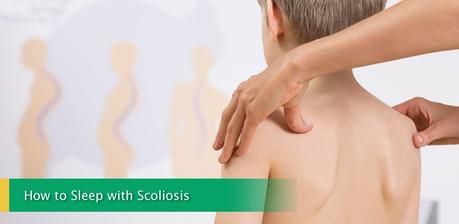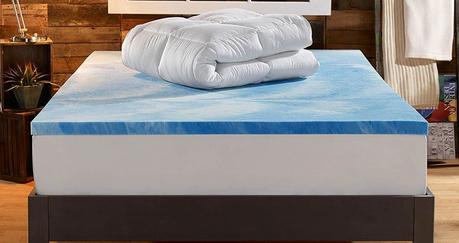Before we consider the best sleeping position for scoliosis, we should first discuss its symptoms and the reasons why many people with the condition find sleep difficult. A normal spine is straight when viewed straight on, from front to back. However, when viewed from the side it is in an elongated 'S' shape. An abnormal spine could curve from side to side rather than run straight down a central line or could have an abnormally large curve at the top which leads to a hunched back.

While such an abnormal curvature of the spine can be serious in some people, the vast majority of cases are fairly mild. In such cases, treatment is often unnecessary although sleep is often difficult due to the pain that scoliosis tends to cause.
Table of Contents
If you have scoliosis then you will likely know all this, and want to know how to sleep with scoliosis with minimal pain. Here are some tips you can try. Everybody is different, and what works for one person may not work for another.
1. Choose the Right Mattress
What is important is that you start with the mattress. Whether you suffer from scoliosis or not, everybody's spine is unique to them. However, if you do, then it is extremely important to choose a mattress for scoliosis that supports your spine in its existing shape.
In other words, it has a neutral effect on the curvature of your spine. Keep in mind that your mattress is fundamentally for comfort and not a therapeutic tool for correcting the abnormal curvature caused by scoliosis. A good quality firm mattress would be best, or perhaps medium to firm. Much depends on your sleeping position which we discuss below.
A memory foam top or topper of around 3 inches thick would be an ideal top layer for your mattress, with a firm lower layer. In some cases, particularly with side sleepers, 4 inches might be required as a top comfort layer. The foam should be thick enough to provide comfort in your chosen sleeping position, but not so thick that your pressure points don't get support from the firm layers beneath it.
We have carefully reviewed a large number of mattresses of various types to find the best mattress for scoliosis. Due to different sleeping positions and mattress preferences, there no single best mattress, but we have come up with six mattresses that we believe are the best we could find. Click the link to check them out. You can also use mattress toppers and pillows to help you sleep with scoliosis.
2. Mattress Toppers
If you don't want to change your mattress just yet, there are many different mattress toppers available to help make your existing mattress more comfortable for you. A mattress topper or pad lies over your existing mattress to rejuvenate it or give it added comfort or firmness depending on your sleeping position.

Back sleepers may prefer a bit more firmness in their mattress, while side sleepers may need a slightly thicker soft comfort layer before hitting the firm support layer below it. We will expand on the importance of your sleeping position below. To choose your preferred mattress topper, check out our review of the best hypoallergenic mattress toppers and pads here.
3. Pillows
Your pillow is an important aspect of getting comfortable with scoliosis. The best sleeping position for scoliosis sufferers involves adequate support for your head and neck. It is recommended that if you have scoliosis, you sleep using a small flat pillow that keeps your head and back straight, larger pillows force your head up, compromising your spine position.
If you sleep on your back, your head may be too high, forcing your neck upwards. If a side sleeper, it will be forced up to the side and your spine will not be straight laterally. Check out our best pillow reviews here and choose the best one for you from our list of 10.
Best Sleeping Positions for Scoliosis
As suggested above, it's not just your mattress that's important but also your sleeping position. You should adopt a way of sleeping that puts the least stress on the shape of your spine.
Side Sleepers:
Over 60% of Americans sleep on their side, and many prefer this position as offering more pain relief than other positions. Most side sleepers sleep in the fetal position. This position helps keep your spine straight, particularly if you sleep with a pillow under your knees or preferably between your legs. This helps open the spinal canal. Try to bend at least one leg forward. Side sleepers put the least strain on the curvature of their spine since their spine is fundamentally straight from top to bottom when viewed from front to back.
If your scoliosis has led to a sideways spinal curvature, let's say curving out to your left hand side, then sleeping on your right side could help correct that as gravity pulls your spine downwards toward the straight position. The mattress should have a comfort rating of soft to medium firm. Say 4.5 - 6.5 on a scale of 1-10. Much depends on your body weight which we shall discuss later.
Back Sleepers:
Around 15% or slightly more Americans sleep on their backs. Most doctors would recommend this position because your body weight is distributed more evenly across the mattress than sleeping on your side. The spinal deformation caused by the condition tends to occur mainly in the middle of your spine - around the thoracic or chest region.
By sleeping on your back, you help to keep your spine in its natural curvature. It also helps ease any pain because your sleeping position is not forcing your spine into an unnatural shape. It is also the best position for those with hyperkyphosis leading to a hunched back. You may also find it more comfortable to place a small pillow or rolled up towel under your neck.
The Importance of Support: One important point for back sleepers: don't sleep on your back with your legs straight out because this can aggravate your condition. Instead, bend your knees and place a rolled up towel below them. You also need good support from the support layer in your mattress.
For this position to provide the most benefit, you should have a firm support layer beneath a thinnish layer of foam - preferably memory foam though latex foam would also be good. Talalay latex is best because it provides a good level of 'push-back' against your spine when you lie on it. If possible try both types of foam as the comfort layer and decide which helps you more. A 2 to 3-inch layer of foam should be enough. The overall comfort rating should be firm to medium firm. Say, 6.5 to 7.5 on a scale of 1-10 where 10 is firmest.
Stomach Sleepers:
You are strongly advised not to sleep on your front, or stomach if you have scoliosis. Your spine will be arched in an unnatural position when you lie on your stomach and so will your neck. These are minor issues if your spine is normal, but with scoliosis, this could possibly make your condition even worse. Sleep on your back if you can't lie on your side.
Sleeping Position - General Factors
Your sleeping position, even if incorrect, will not cause scoliosis and usually not even make it worse. However, the above advice should enable you to sleep more comfortably and easily, and wake up feeling refreshed rather than sore. That's mainly because your spine will be in a relatively neutral position, rather than in one which can add to your pain.
There are two major types of the curve in a spine affected by scoliosis. You can help to reduce any pain or discomfort associated with these by the use of strategically placed pillows or rolled towels. Make sure you inform your doctor to make sure you won't be restricting the flow of spinal fluid or blood.
These curves are:
Thoracic Curve: This is a scoliosis curve in the thoracic (chest) region of your spine. Back sleepers can get some relief by placing a small, thin pillow under the area of their shoulder blades. This should relieve at least some of the pressure on your spine. Side sleepers can support their spine by placing a thin pillow beneath the top part of their ribcage.
Lumbar Curve: You lower back, where your spine naturally curves inwards, is also known as your lumbar region. A lumbar curve accentuates this, and it can be painful if you sleep on your back. To alleviate this, place a pillow under your lower back. You should already have a rolled towel or small pillow beneath your neck to help straighten your spine.
How to Sleep With Scoliosis: Conclusion
Although many people have scoliosis, every case can be different. What works for your friend might not work for you, partially because it is not the curvature of your spine that causes the pain. It is mainly the way your own muscles react to that curvature. Some muscles become stronger to compensate for those that become weaker, causing an uneven reaction that shows itself as spasms.
These can cover the whole gamut from annoying to extremely painful, and not only prevent you from sleeping, but when you do sleep it can wake you during the night. However it affects you, our tips above should help you to sleep with scoliosis.

